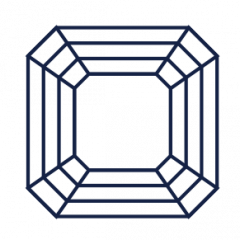Asscher
The Asscher cut dates back to the early 20th century when jeweler and diamond cutter, Joseph Asscher, developed the design in his Amsterdam atelier. This new design coincided with the birth of the Art Deco movement. Perhaps one of the most famous diamonds of all time, worn by Elizabeth Taylor, was a jaw-dropping 33.19 carat Asscher called the “Krupp Diamond.”
What is an Asscher cut diamond?
The basics
The Asscher cut diamond has 72 facets, which are larger and wider-set—three rows on top and three on the bottom. The elegant step cut draws your eye into the center of the stone, both captivating and mesmerizing anyone who catches its gaze with its flashes.
The Asscher is often labeled as a cut-cornered square step cut, a square emerald cut or an octagonal cut by the GIA when grading diamonds of this shape.
Why should I choose an Asscher cut diamond?
The Asscher creates an incredible optical illusion known as the “Hall of Mirrors”, also seen in emerald cut diamonds.
Because this shape is so similar to a natural diamond crystal, the Asscher also has minimal waste during the cutting process, which means Asscher diamond engagement rings are excellent value for money.
You’ll frequently see Asscher diamonds set in vintage jewelry with details featuring geometric shapes or filigree work. Give a nod to the past by using an Asscher in an antique setting or juxtapose its old-world quality with a more contemporary design.
Due to its open, step-like facets, it’s best to optimize on clarity when choosing an Asscher. A clarity grade of VS2 (very-slightly included) and above will ensure a completely eye clean appearance.
David Macdonald, Diamond Buyer
The length to width ratio of Asscher cut diamonds usually ranges from 1.00 – 1.05. Anything less than 1.04 appears square to the naked eye.
Asscher cut diamonds also come in elongated shapes with ratios above 1.05 for a longer, narrower aesthetic.

Asscher Cut Guide
While Asscher cut diamonds don’t have an official cut grade, the chart below offers general guidelines to follow when considering the cut of an Asscher cut diamond.
| Excellent | Very Good | Good | Fair | Poor | |
|---|---|---|---|---|---|
| Table % | 61-69 | 57-60 or 70-72 | 54-56 or 73-74 | 51-53 or 75-79 | <51 or >79 |
| Depth % | 61-67 | 59-60.9 or 67.1-70 | 57-58.9 or 70.1-74 | 54-56.9 or 74.1-79 | <54 or >79 |
| Girdle | Very Thin - Slightly Thick | Very Thin - Slightly Thick | Very Thin - Thick | Very Thin - Very Thick | Ex. Thin - Ex. Thick |
| L/W Ratio | 1.00-1.03 | 1.00-1.03 | 1.04-1.05 | 1.06-1.08 | >1.08 |
Asscher Color Guide
What color should I choose for an Asscher cut diamond?
Evaluating color in Asscher cut diamonds is entirely dependent on the preference of its buyer or wearer.
Customers may prefer the warmer tones of color grades G-H to the icy cool tones of color grades D-F. The truth is, the difference between these two color grade ranges is difficult to perceive, especially to the naked eye.
However, due to the large, open facet structure of an Asscher cut, any color present in the diamond will be more visible. The color chart below serves as a general guideline when it comes to choosing a color grade for Asscher cut diamonds.
| Excellent | Very Good | Good | |
|---|---|---|---|
| <0.50ct | D-G | H-I | J |
| 0.51-1.00ct | D-F | G | H-I |
| 1.00-2.00ct | D-F | D-F | G |
| >2.00ct | D-F | D-F | G |
Asscher Clarity Guide
What clarity should I consider when choosing an Asscher diamond?
Diamond clarity grade is dependent on personal preference. When diamonds are formed deep in the earth, they develop clarity characteristics–slight irregularities visible under 10x magnification. Depending on the size, quantity, placement, tone or color of these clarity characteristics, they may or may not be visible to the naked eye. This is one of the reasons why a truly flawless diamond is so rare.
Due to the open facet structure of Asscher cut diamonds, there’s no place for inclusions to hide.
Because of this, we recommend considering clarity first when choosing an Asscher cut diamond, before selecting your color grade and carat weight.
We recommend a VS1 clarity grade or higher to ensure an eye-clean appearance.
| Excellent | Very Good | Good | |
|---|---|---|---|
| <0.50ct | FL-VS2 | SI1 | SI2 |
| 0.51-1.00ct | FL-VS1 | VS2 | SI1 |
| 1.00-2.00ct | FL-VVS2 | VS1-VS2 | SI1 |
| >2.00ct | FL-VVS2 | VS1 | VS2 |























